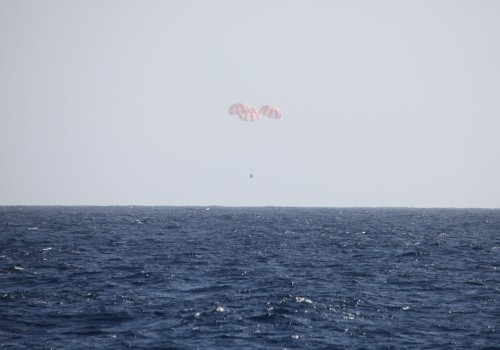Dragon Returns Safely (Again), Time to Speed Up Commercial Crew?
For what is now the fourth time, a Space Exploration Technologies Dragon spacecraft has successfully returned from Earth orbit to a well executed landing in the Pacific ocean. Following its release from the International Space Station, which took place in the early morning hours, the SpaceX CRS-2 Dragon performed three inital burns, followed by a sustained 10 minute de-oribit burn at 10:42 AM CST to begin its dive into the upper atmosphere. After shedding its “trunk” and solar power arrays to safely burn up during their own re-entry, the Dragon used its Draco thrusters to fine tune its landing trajectory into a recovery ellipse which is considerably tighter than that of the Russian Soyuz, which once again took place within visual observation of the awaiting recovery ship, slashing down at 9:34 AM PT. Barely half an hour later, Elon Musk tweeted that recovery operations were underway, with the spacecraft being secured aboard the chartered recovery vessel.
Although this mission, CRS-2, will no doubt be remembered primarily due to the initial difficulties in pressurizing the Draco thrusters, it is well worth considering from another point of view. In conducting the fourth recovery of an orbital spacecraft which could have supported a human occupant, SpaceX is beginning to approach some very interesting benchmarks in its pursuit of human crew certification. For consideration; China, to date has only conducted four crewed flights of its Shenzhou spacecraft, with a fifth flight scheduled for this summer. In terms of capability, SpaceX has now carried as many human capable flights as the China has conducted actual crewed flights, although it should be noted that China also launched a total of 5 uncrewed missions as well.
Looking back into U.S. history, the Dragon has also now completed as many orbital flights as manned orbital flights conducted under Project Mercury; specifically the Mercury Atlas missions of John Glenn, Scott Carpenter, Wally Schirra and Gordon Cooper. To be sure, Project Mercury also included a large number of unmanned suborbital test flights of variation duration, as well as two orbital test flights, one unmanned, and one crewed by a justifiable angry chimpanzee, and of course, the two sub-orbital missions of Alan Shepard and Gus Grissom.
While the fact that the each of the Dragon flights could have theoretically hosted a human occupant does not mean that it is practically capable of doing so at the present time, it does clearly suggest that SpaceX, with the help of NASA, has made huge strides which are already bringing it on par with historical and current systems, and casting a strong contrast with the tepid pace of the Commercial Crew program financially hamstrung by Congress.
In introducing the Falcon 9 v1.1 on the company’s next flight, SpaceX is adding a degree of uncertainty that will take some time to be retired, but with a successful debut, the reliability of the new version could be well on the way to being established by the time of the NASA CRS-3 mission scheduled for the end of this year. The bottom line, with 5 launches of the original Falcon 9, and four orbital Dragon missions already in the history books, it may be time to take the training wheels off this aspect of the U.S. space program, or accept the fact that it will likely be permanently eclipsed by bolder visions of how to employ the hardware at hand, such as that offered by the Inspiration Mars Foundation, which was also no doubt paying attention today. Presumably, each new flight of the Dragon, protected as it is by a heat shield composed of material already capable of withstanding the type of re-entry under consideration for the proposed Mars circumnavigation helps to build the case for the project, even though no hardware has been selected.
In the light of all that has been accomplished, current predictions of a 2017 first flight for NASA astronauts as part of the Commercial Crew program are painfully underwhelming and arguably unworthy of this nation’s past. Executive branch leadership may be too much to ask for, but it would certainly be useful.


